The chain link is an important part in the track of construction machinery such as bulldozers and excavators, and the market demand is large. The working condition of the chain rail section is harsh, its stress is complex, and it needs to bear a large random alternating load in the working condition. It is one of the most vulnerable parts of the crawler engineering machinery walking system. The quality of the chain rail section directly affects the crawler belt. The service life of the assembly. The chain rail section is produced by die forging process. The traditional process is cutting and cutting → medium frequency induction heating → air hammer blanking → friction press or electric screw press forging → crank press trimming, punching, correction → adjustment Heat treatment. It has the following disadvantages: (1) There are many equipments and operators required. The process has many processes, many equipments are used, and the main processes are all manual operations, and the degree of automation is low. A chain link production line needs 10-15 people; (2) the production efficiency is relatively low. The manual operation and more processes reduce the production efficiency, and the output is about 300 pieces/hour without considering the equipment failure and debugging the tooling; (3) the forging quality is unstable. Manual operation has high skill requirements for personnel and poor consistency of forgings. The turnover between multiple equipments is likely to cause bruises on the surface of forgings, and the forging temperature is not easy to control, affecting the quality of forgings; (4) The energy consumption of heating furnaces and forging equipment is high.
With the development of the domestic construction machinery market, the competition is becoming more and more fierce, and the quality and cost requirements for products are getting higher and higher. At present, the human resources in the hot forging industry are seriously lacking, and the labor costs are increasing year by year. To solve this problem, automation is the best path. Automation reduces the dependence on labor, avoids human factors in the process, and the product quality is stable and reliable, and the production efficiency is improved. Under this situation, the traditional forging production equipment and production process need to be upgraded. Our company's automation chain link forging production line and the corresponding chain link forging production process have certain representative significance in the development of domestic forging automation.
Chain rail forging production process
Different forging production processes are based on different forging production lines. Multi-station hot forging presses are easier to automate than traditional forging equipment. The crank forging press produced by Miller Wanjiadun Company introduced by our company can install the complete set of molds of five stations, and can complete the forming of multiple stations in the same stroke. We use this equipment to For example, the 190mm pitch chain link forging (Fig. 1) is designed with the following forging process: shear cutting→automatic feeding→medium frequency induction heating→feeding temperature automatic sorting→squeeze on hot die forging press, pre-forging , final forging, punching and trimming correction → automatic temperature separation of workpieces → residual heat quenching and tempering.
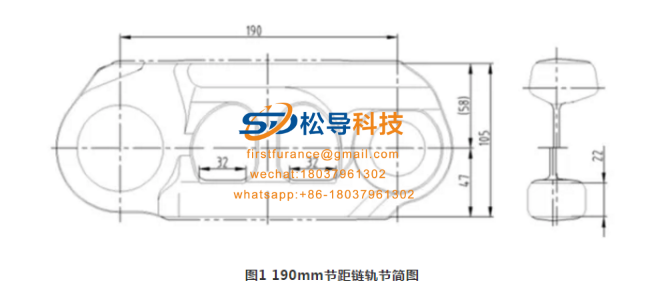
Automated chain link forging production line
The production cycle of the automatic chain link forging production line is 4~5s/piece, and the output per hour can reach more than 700 pieces in continuous operation. It mainly produces a variety of chain link forging products with a pitch of 190mm~203mm. The main engine model is PK3150 hot forging press with a maximum load of 3,150 tons. Its frame and drive system are designed for high load and precision production, especially suitable for the automatic production of large quantities of forgings. The whole production line is equipped with automatic feeding device, mold release agent automatic spray system, workpiece temperature control conveying system, rapid die changing system, etc., which can realize the automatic production of workpiece from loading to product. In normal production, the entire production line requires only three operators, mainly responsible for the control of the heating furnace and the main panel, the abnormal processing of the production line and the full line inspection.
The overall length of the automated chain link forging production line is about 80.2m and the width is about 12.5m. They are respectively fed by the feeding device, medium frequency heating furnace, material temperature sorting device, hot forging press, forging conveying chain, residual heat quenching device, and back. The composition of the furnace, each part is connected by a slide or a transmission chain, and its equipment composition, function and characteristics are respectively introduced as follows.
Automatic feeding system
In recent years, in the forging production, more and more manufacturers use induction heating, but the induction heating of the loading and unloading is mostly done manually, generally requiring 1 or 2 operators.Manual loading increases labor costs, and human factors inevitably affect production efficiency. The adoption of an automatic feeding system can eliminate this effect and better utilize the advantages of induction heating.
The loading system of the automated chain link forging production line consists of a turning hopper, a vibration lifting feeder, a horizontal conveyor and a pressure roller pushing mechanism, as shown in Fig. 2.
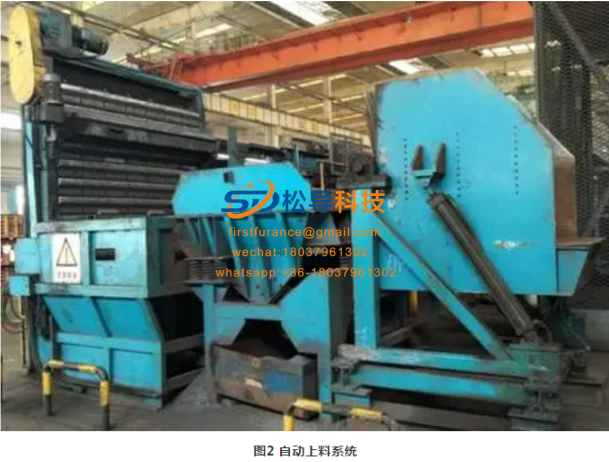
Before the start of production, the operator places the basket filled with bar material in the inverting hopper. The cylinder pushes the hopper to turn over, and pours the bar into the vibrating bucket of the vibrating lifting feeder. The vibrating bucket passes the vibration at intervals. The bar material is fed into the bottom of the lifting chain of the lifting feeder, and the bar material is sequentially sent into the track of the horizontal conveyor through the lifting chain, and the bar material is sent to the pressing roller pushing mechanism through the conveyor chain, and the operator can heat The feed speed is adjusted on the system control panel to control the press roll speed to adjust the production cycle. When there is no bar at the pressure roller, the control system will send a material shortage alarm signal to inform the operator to feed. In normal production, a basket of bars is usually added for half an hour.
Bar heating and temperature separation
The rated power of the intermediate frequency heating furnace is 3000kW. In actual production, according to the product model and the production cycle, the bar heating temperature is controlled by adjusting the value of the output power percentage. The inlet of the induction heating coil of the intermediate frequency heating furnace is connected with the pressure roller pushing mechanism of the feeding system, thereby controlling the production cycle of the entire production line. At the same time, in the middle and outlet of the induction heating coil of the intermediate frequency heating furnace, there is a pressure roller pushing mechanism, wherein the pushing speed at the outlet is the largest, slightly higher than the pushing speed of the middle pressing roller, and the pushing speed at the inlet. The smallest, this design can ensure smooth delivery of the bar.
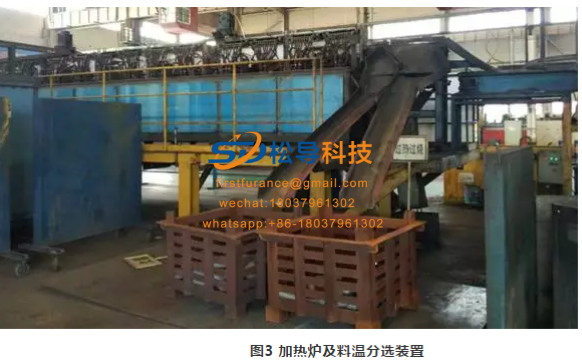
The outlet of the induction coil of the intermediate frequency heating furnace is equipped with an automatic material sorting device, which is composed of an infrared thermometer, a three-bar bar sorting device and a discharge chute, and the discharge chute includes a normal chute, an under-temperature chute and Over-burning slide, as shown in Figure 3. The operator can set the upper and lower limits of the bar temperature on the heating system control panel. The infrared thermometer collects the temperature information and feeds back to the control system. The control system controls the sorting device to send the bar below the lower limit temperature into the owed. On the warm slide, the bar above the upper limit temperature is sent to the over-sliding chute, and the bar of normal temperature enters the next station through the normal chute. The material temperature automatic sorting device can strictly control the bar temperature to ensure the quality of the forging and the smooth production.
Hot forging press forging
The hot forging press has the advantages of high production efficiency, fast striking speed, short thermal contact time of the mold, long service life of the mold, and the like, and is suitable for an automated forging line for mass production. The PK3150 hot forging press (Fig. 4) equipped with this line adopts a double drive mechanism, which can further reduce the mold time, reduce mold wear, extend mold cooling and part transfer time, and improve productivity. The maximum stroke can reach 60 times/min. .
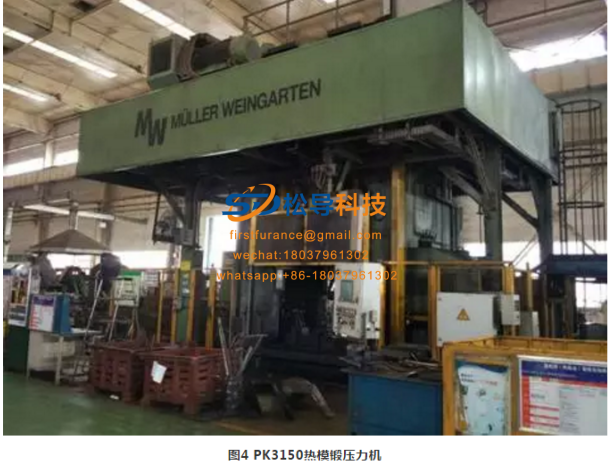
The entire forging system consists of a template changer, a mold release agent automatic spray system, a walking beam conveyor system and a main unit. The blank is formed by one station flattening, two station pre-forging, three-station final forging, and four-station punching and trimming.
At the beginning of production, the operator starts the main machine. After the control system detects that the signals are normal, the press starts the stroke, and the walking beam system and the spray system start the mechanical action. The bar heated to the forging temperature is cut into the gripping position of the robot by the normal slide. After the proximity switch detects the signal, the robot grabs the bar to the rotating table, and then moves the jaws on the walking beam to each Station. A proximity switch is mounted in the walking beam to transmit a signal to the control system as the workpiece is captured. The automatic spray system follows this signal to spray the corresponding station, and the operator can adjust the spray volume according to the production situation. When the length of the bar is out of tolerance or the workpiece is caught abnormally, the control system issues a fault alarm, the device is suspended, and the operator processes it. The press accurately displays the forging load of each station and has an overload protection system. In normal production, the quality of the forgings is basically unaffected by the skill level of the operator, ensuring the stability of the product quality.
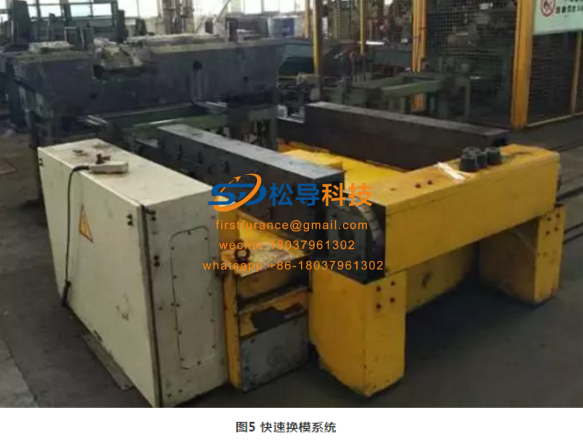 The production line is also equipped with a quick die change system consisting of a die change trolley, a guide rail, and a template changer (Fig. 5). The press is equipped with two sets of change plates, one for forging production on the press, and the other for mold assembly in the mold shop. When the production needs, the replacement of the template can be completed within 20 minutes. By applying rapid die change technology, a large number of internal mold changing operations can be converted to external operations, thereby reducing equipment downtime and increasing production efficiency, which is important for achieving forging automation.
The production line is also equipped with a quick die change system consisting of a die change trolley, a guide rail, and a template changer (Fig. 5). The press is equipped with two sets of change plates, one for forging production on the press, and the other for mold assembly in the mold shop. When the production needs, the replacement of the template can be completed within 20 minutes. By applying rapid die change technology, a large number of internal mold changing operations can be converted to external operations, thereby reducing equipment downtime and increasing production efficiency, which is important for achieving forging automation.
Afterheat quenching and tempering
The residual heat quenching process has been widely used in track component products such as chain rail joints. The residual heat quenching process can eliminate a quenching heating process, and the forgings subjected to residual heat quenching not only have excellent comprehensive mechanical properties, but also have reduced cost and improved production efficiency.
Figure 6 shows the residual heat quenching and tempering line. After the chain link is forged, it is moved to the main conveyor chain by the walking beam. After the hot forging passes through the proximity switch on the main conveyor chain, it is distributed to two parallel sub-transport chains. Two baffles controlled by proximity switches are provided on each sub-transport chain to adjust the direction in which the forgings are placed.
![]()
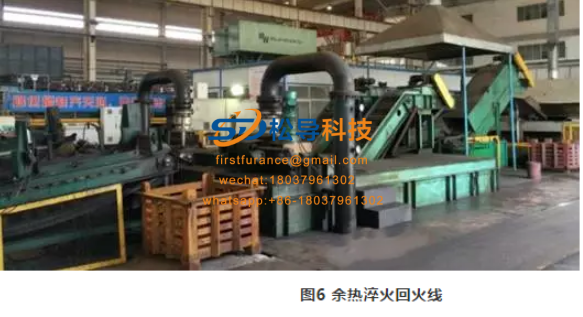 The end of the transfer chain is equipped with an automatic temperature sorting device for forgings. After being measured by an infrared thermometer, the forgings whose temperature meets the requirements enter the residual heat quenching machine, and the other forgings are pushed into the material basket on one side to enter the quenching and tempering process.After the forgings are quenched by residual heat, they are washed into the cleaning tank through the lifting chain, and then sent to the tempering furnace by the distributing machine for tempering.
The end of the transfer chain is equipped with an automatic temperature sorting device for forgings. After being measured by an infrared thermometer, the forgings whose temperature meets the requirements enter the residual heat quenching machine, and the other forgings are pushed into the material basket on one side to enter the quenching and tempering process.After the forgings are quenched by residual heat, they are washed into the cleaning tank through the lifting chain, and then sent to the tempering furnace by the distributing machine for tempering.
Conclusion
The automated chain link forging production line realizes the automatic production of chain rail forgings from loading to heat treatment, with a maximum output of more than 5,000 pieces. The number of on-site operators has been reduced from more than ten people in the ordinary production line to three, and its main responsibility has been changed from manual labor to control and maintenance of the production line. The automation of the production process eliminates the impact of human factors on production efficiency and product quality, and improves product stability and consistency. At the same time, enterprises should pay attention to building a high-quality automation equipment maintenance team to ensure the stable operation of automation equipment and improve the comprehensive utilization of equipment.

